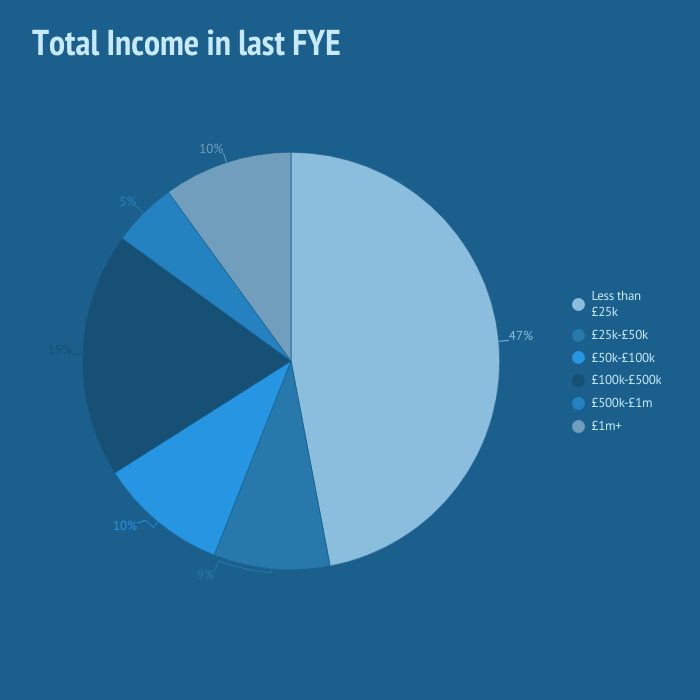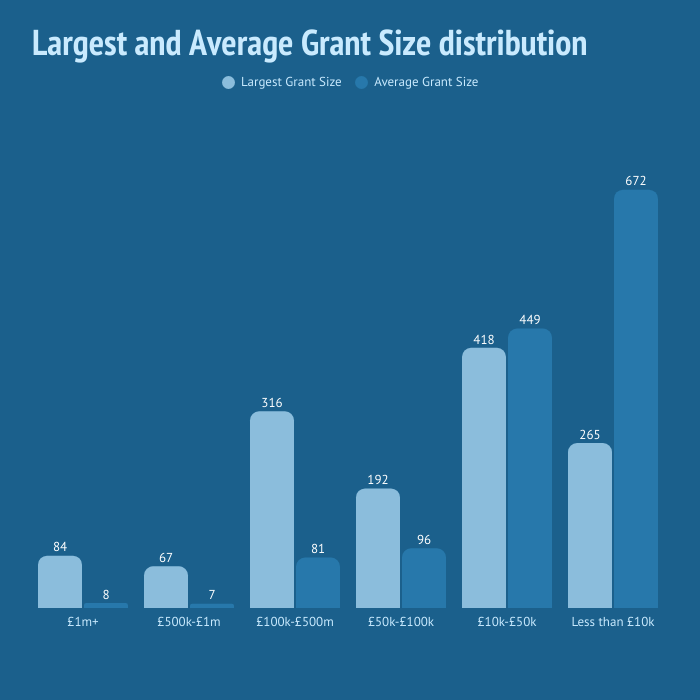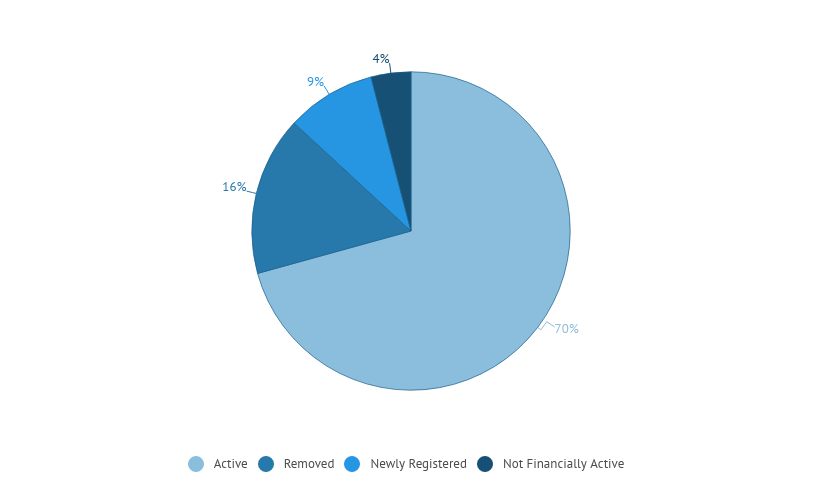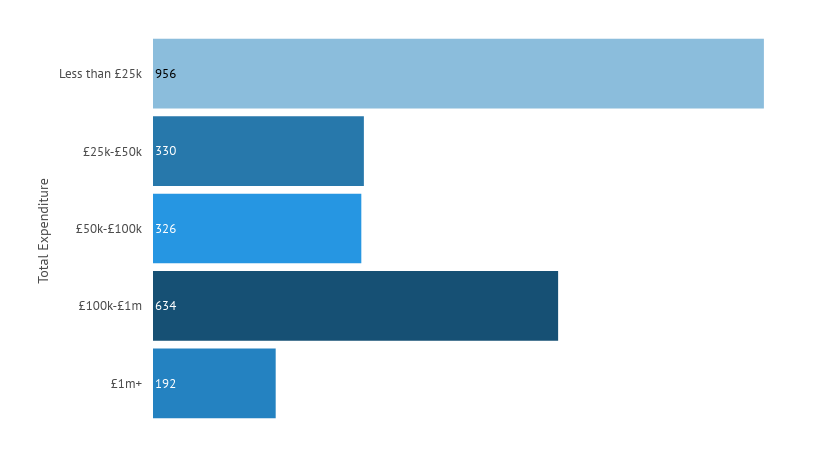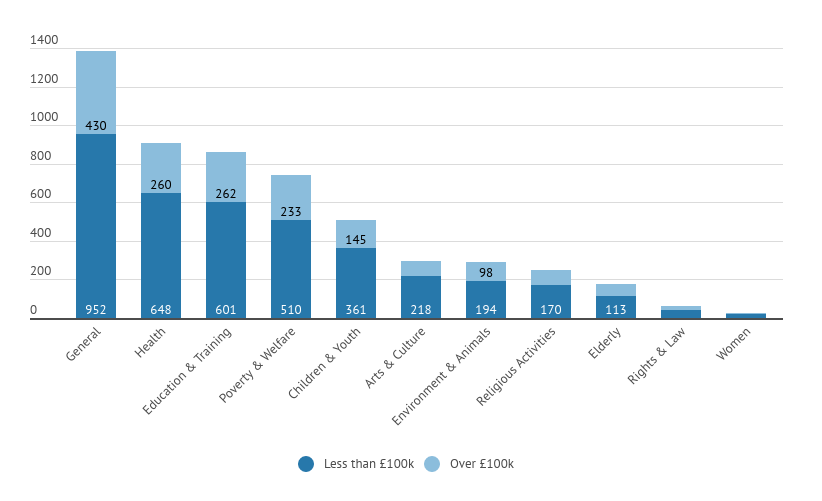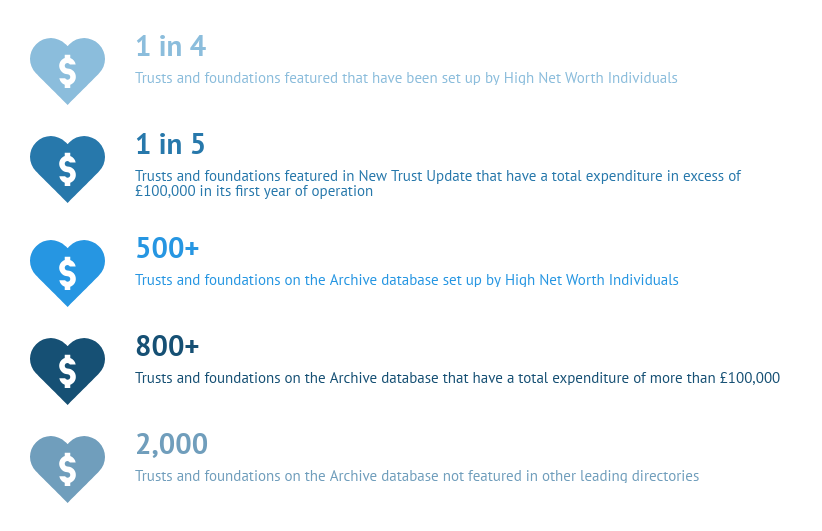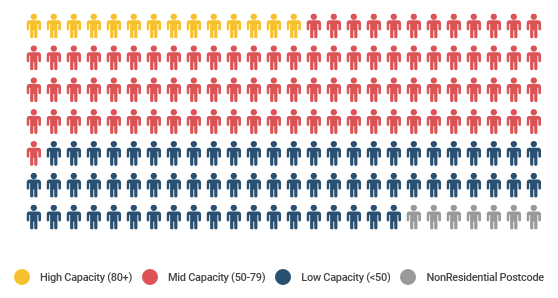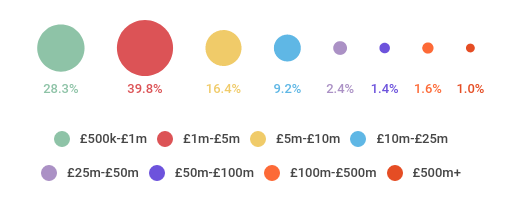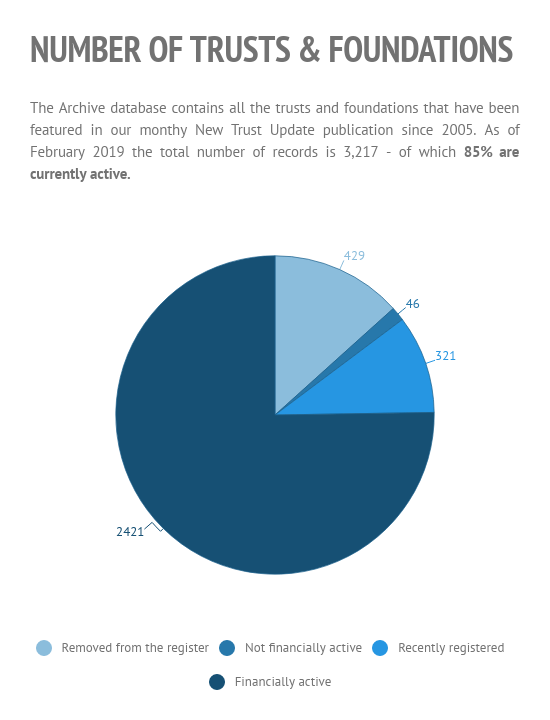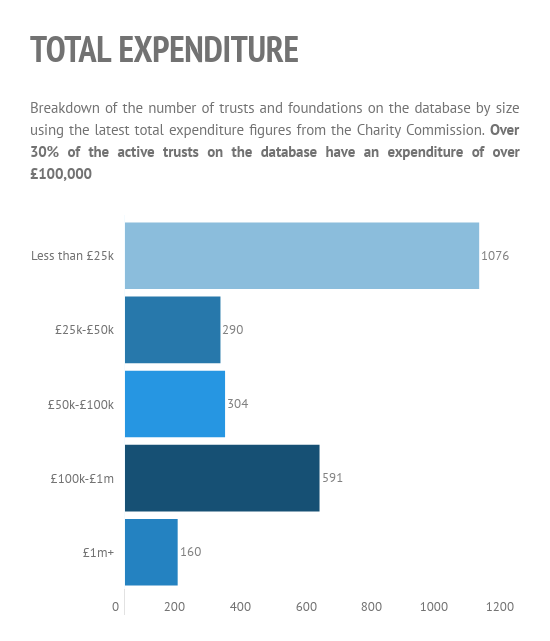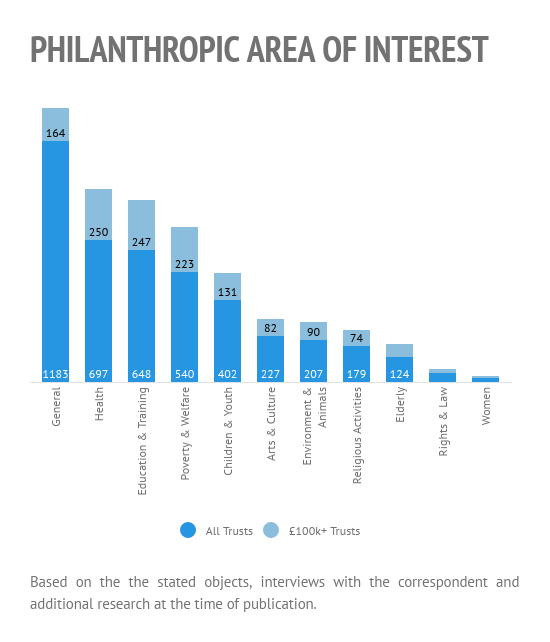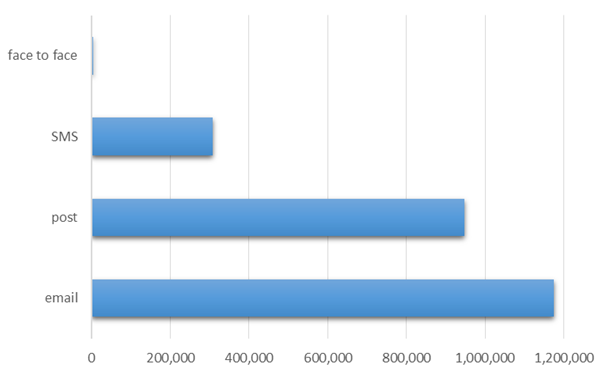Following on from our previous post looking at the make-up of Factary’s New Trust Update Archive Database, in this blog we take a closer look at the reported and identified areas of interest of the funders in our new database.
There are some surprising results, with encouraging findings if you are fundraising for projects for women, the environment and mental health amongst others.
First we examine the number of funders supporting the various philanthropic areas of interest in the database. Then we look at the level of funding potentially available in each area. Then we look at interesting trends in the data.
Classification of funders
All the funders in the database have been reviewed and their philanthropic areas of interest classified based on:
- their charitable objects,
- the Activities section of their Charity Commission entry,
- their website (if available),
- the Trustees’ reports in the annual accounts, and
- noticeable trends in their reported grant-making.
Many funders are registered with General Charitable Purposes when we first feature them in our monthly New Trust Update reports. Reviewing these trusts and foundations after they have been established for a few years, we find we are able to classify them more accurately based on the information now available to us.
Factary’s classification system
We have expanded on the basic classification system used by the Charity Commission and the International Classification of Non-Profit Organizations (ICNPO). We feel these systems are too limited and simplified to be truly useful for fundraising.
Factary’s NTU classification system is focussed on fundraisers’ needs, and is based the types of project you have asked us to research during our thirty-plus years working in the UK charity sector.
The categories and how they’re assigned
Funders are assigned multiple classifications to reflect the various different interests and grant programmes they offer.
In some cases we apply standalone categories, such as Christianity or Environment. Where appropriate, we combine classifications to categorise a funder’s activity. For example, a funder working in children’s health would be assigned to two categories: Children & Youth and Health. The classifications we use in our database are:
- Animals
- Armed Forces
- Arts & Culture
- Children & Youth
- Christianity
- Community
- Disability
- Education & Training
- Elderly
- Emergency Services
- Environment
- General Charitable Purposes
- Health
- Heritage
- Higher Education
- Hospices
- Housing
- International Development
- Islam
- Judaism
- Mental Health
- Other Religions
- Political Body
- Research
- Rights, Law & Conflict
- Sports & Recreation
- Welfare
- Women
Activity Overview
The graph below provides an overview of the number of funders with reported or identified philanthropic interests in each of the Factary’s classification areas.

The data shows that many trusts and foundations continue to focus on General Charitable Purposes, years after they are first registered. This is a reminder that even for organisations operating in a less-represented or ‘niche’ category, there are plenty of funders potentially open for applications.
Outside General Charitable Purposes, the three largest categories are Welfare, Education & Training and Health.
These are broad categories that can cover a wide range of areas and beneficiaries. This is particularly the case with Welfare, which encompasses all general areas of disadvantage – old age, poverty, circumstance and so on.
In addition to such broad categories, which reflect the wide interests of such funders, we assign funders to more specific categories wherever we can. These include Housing, Women, Children or Elderly. So, while more general Welfare funders will of course be of interest to charities working in these areas, the more specific funders we’ve identified will also be of interest (potentially greater interest).
It’s a similar case with Health. Here, we have separate categories for palliative care (Hospices) and Mental Health, and an additional category of Research that can be used in conjunction with Health to identify medical research funders. As above, specialised charities will be interested in funders whose interests we have been able to specify, along with the more general Health funders.
Expenditure and Activity
The first graph below shows total charitable expenditure from the last financial year for funders on the NTU database, broken down by activity type. This total charitable expenditure broadly mirrors the total number of funders in each area in terms of those areas with the greatest potential funding available; Education & Training, Health, Welfare and Children & Youth.
(Note that each category gives the total expenditure of the funders, and has not been broken down by funders’ expenditure on any particular philanthropic area – many funders have multiple areas of interest.)
In the other graph below, we provide funders’ median average expenditure , broken down by philanthropic area of interest. (We have excluded dormant funders, i.e. those with no recorded expenditure in recent years.)
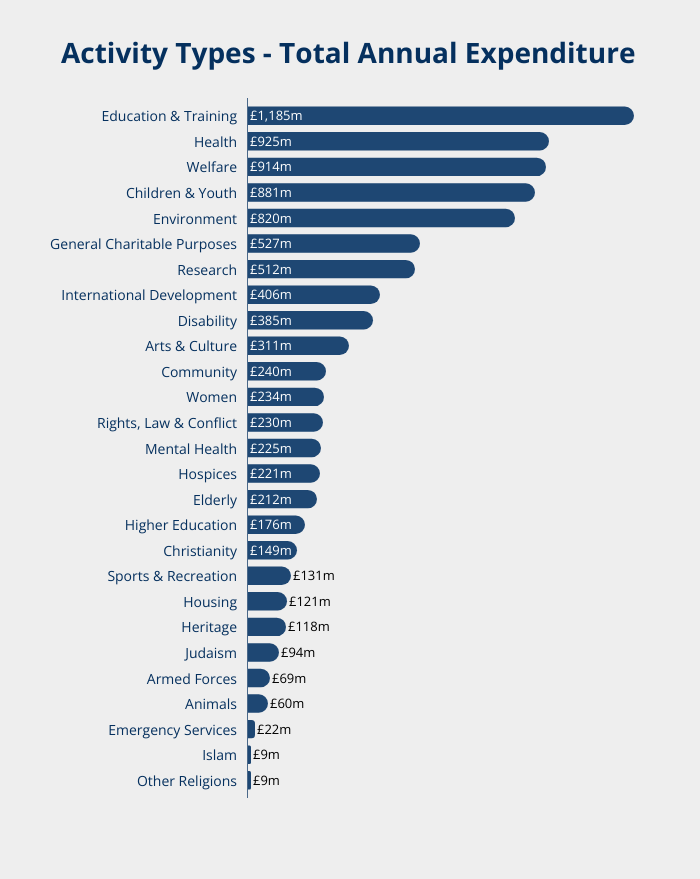
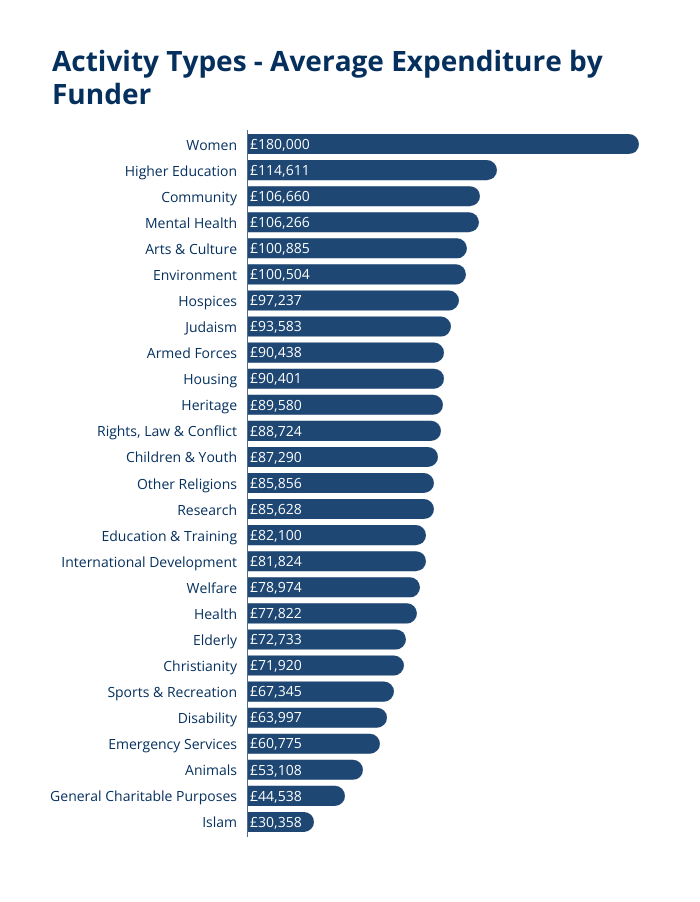
This average expenditure graph shows that the areas of philanthropic interest with the largest funders in terms of expenditure are Women, Higher Education and Community.
Average expenditure of funders who support the category of Women is significantly higher than any other area. Funders in this area include some of the largest foundations in the UK, such as the AKO Foundation, Fondation Chanel and the Moondance Foundation.
Mental Health, Arts & Culture and Environment also appear to attract the largest funders, all appearing high in the rankings.
Higher Education also attracts some large foundations such as The Huo Family Foundation (UK), The Rumi Foundation and The Law Family Charitable Foundation.
Those at the other end of the scale include Islam, Animals, Emergency Services and Disability. Disability and Animals are notable, as whilst there are many funders with an interest in these areas (400 and 200 respectively), they appear to tend to be smaller in terms of expenditure.
Again, we note that the total and average expenditure is for the funders as a whole, and is not broken down by their expenditure to each philanthropic area. However it does serve as an indication of the potential funding available for the various philanthropic areas.
The full data for these graphs is available in the following table:

Comparison
It is useful to compare these two graphs, above, because they represent the increasing specialisation and focus amongst philanthropic trusts and foundations.
For example, while funders supporting Community are 11th in rank order of total expenditure, they place third in average expenditure. This implies that a small number of foundations are increasingly focused on that area of work.
This is good news for fundraisers in women’s and community organisations, because NTU data allows you to focus on those high-value funders.
Median grant size
One further level of analysis we can do is look at the median grant size of the funders by philanthropic area of interest.
Of course, not all funders disclose their grant-making. In addition, many of the funders on the NTU database are small, and as such are not obliged to publish their accounts with the Charity Commission. Because of this, grant data in the Archive Database is incomplete, with data only available for around one in three funders.
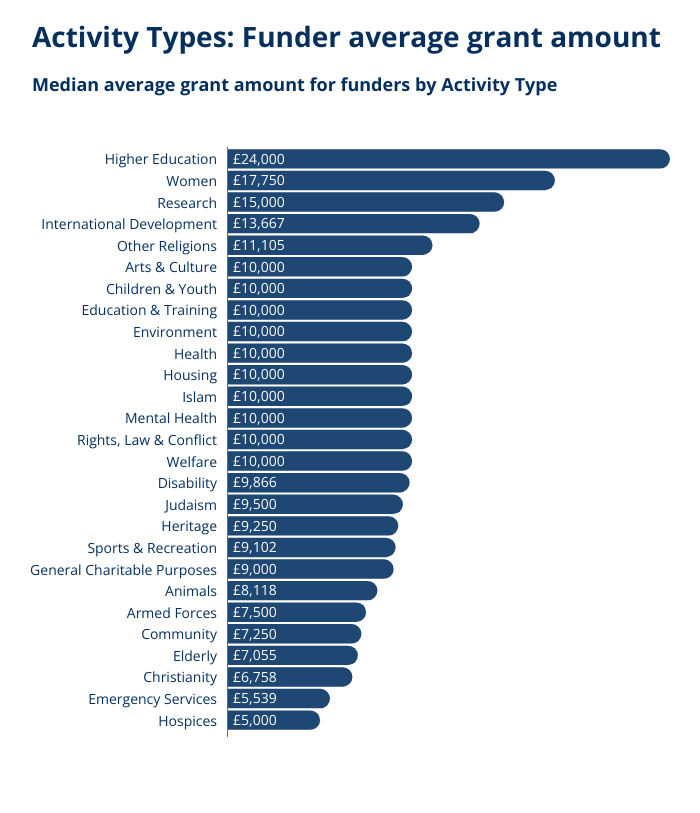
The median reported grant size across the whole dataset is £10,000.
For the same reasons that grant data is incomplete on the database – smaller funders are exempt from submitting accounts, and many larger funders only disclose grants over a certain level – this is likely to be higher than the true average across the sector.
Again, Higher Education and Women are at the top of the list in terms of median average grant size, with Research, International Development and Other Religions all attracting above-average grants from the funders that support these areas.
Those areas that receive support from funders who appear to award smaller-than-average grants include Hospices, Emergency Services, Christianity, Elderly and Community.
We note, however, that the total expenditure of Community funders is high. This is likely to be due to the number of County or Regional Community Foundations on the Archive Database, and their tendency to provide a large volume of small grants to grassroots community organisations.
Notable Trends
We have analysed the philanthropic activity types against the year funders were registered with the Charity Commission. This is to see if we can identify any notable trends in philanthropic interests over time.
Many causes and interests have remained consistent with little noticeable increase or decrease in the number of funders each year. These include Arts & Culture, Christianity, Education & Training, Health, International Development and Welfare.
Growing areas of interest
However, we can see clear trends in some philanthropic areas of interest, most notably year-on-year increases in the number of funders set up with an interest in the areas of Environment and Mental Health, and to a lesser extent Rights, Law & Conflict (human rights, refugees, asylum seekers and so on).
Whilst the overall numbers remain relatively low compared to the most commonly supported activities, there is a noticeable increase over the past decade or so.
With Environment and Mental Health, this can be seen to reflect the growing public awareness and importance of these issues; philanthropists are responding accordingly. This is also reflected in incident rates for ‘climate change’ and ‘mental health’ on the Factiva press database, which show a strong correlation in terms of upward trends in recent years:
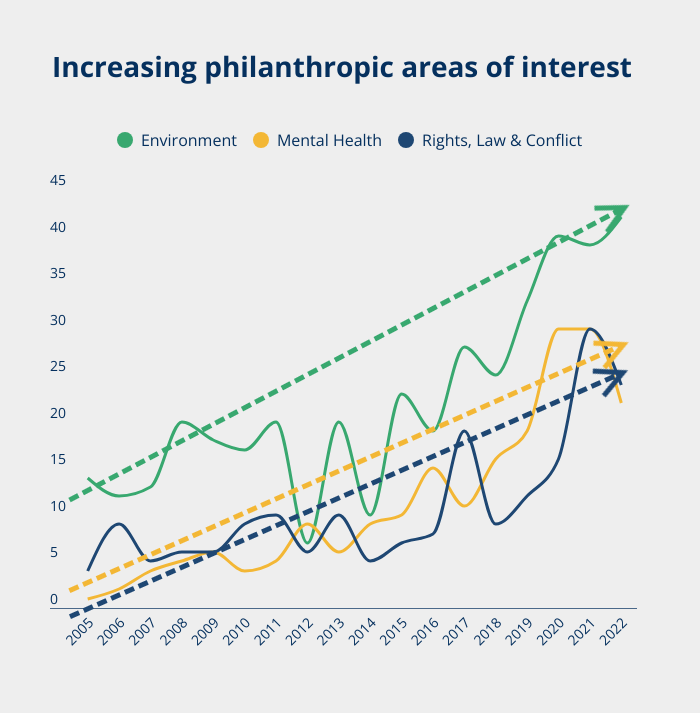
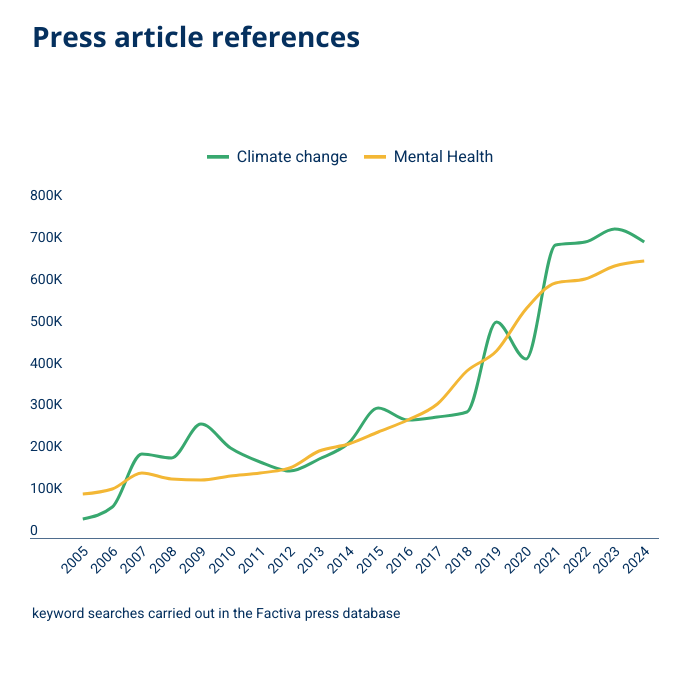
(Note that the graph charting increasing registration of funders in philanthropic areas of interest ends with 2022. This is because trusts registered in subsequent years are still ‘newly registered’ and can’t be properly reviewed based on their funding activities.)
The Covid Effect?
Another interesting trend that appears when we look at the number of funders set up each year is a noticeable spike in 2020 and 2021, when the Covid pandemic was at its height.
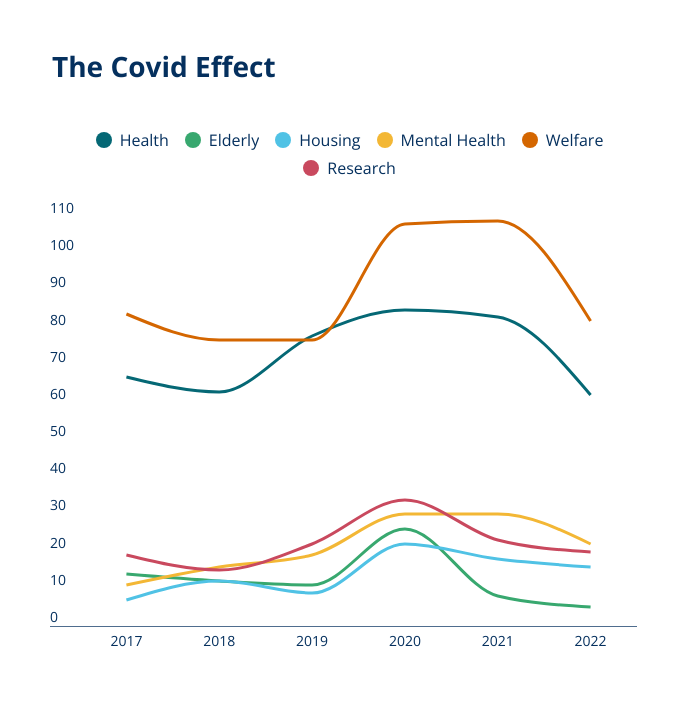
This is particularly apparent when looking at Health, Welfare, Elderly, Housing, Mental Health and Research.
This is another clear example of philanthropists responding to world events and this being reflected in the aims and interests of the charitable trusts and foundations being established.
It also highlights the value of such resources as the New Trust Update, allowing charities to find out about these new sources of funds at the time when the need is most pressing.
About the New Trust Update Archive Database
Factary’s New Trust Update is a subscription service that gives you access to a monthly report profiling the most recently-registered grant-making trusts. The New Trust Update provides information, where available, on funders’ aims and interests, as well as background information on the trustees and settlors. The reports also include updates on previously featured trusts and foundations.
The New Trust Update Archive Database contains over 3,500 funders that have been featured in our monthly reports since 2005. The majority of these funders do not appear in any other leading directories. They have all been reviewed and accurately classified based on their areas of interest and geographic areas of benefit, and the database is fully searchable on a range of criteria:
- Philanthropic areas of interests
- Geographic area of benefit
- Grant capacity / financial size
- Objects
- Trustees
- Biographic and research notes
- Additional classifications including:
- corporate foundations
- ‘Foundations of Wealth’ (i.e. funders established by a HNWI)
- open to unsolicited applications
- and more.
If you would like to learn more about this service and receive a free online demonstration of the database please contact Will Whitefield at will@factary.com or call us on 0117 9166744.




